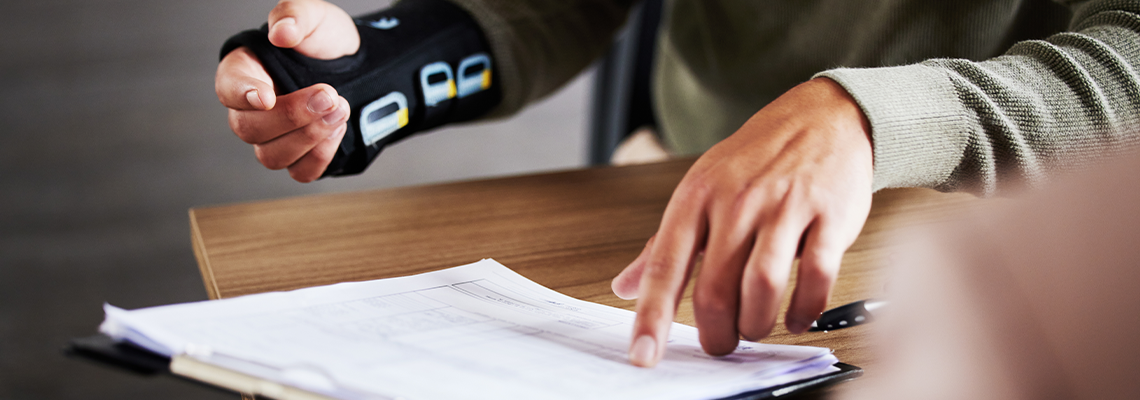
Evidence After an Accident
Dealing with a personal injury is a traumatic experience, filled with emotional and physical turmoil. At times like these, seeking compensation for your damages can be extremely beneficial, and collecting evidence after an accident is crucial for building a strong personal injury claim.
Whether you’ve been involved in a car accident, a slip and fall, or any other type of incident caused by someone else’s negligence, gathering the right evidence can significantly impact the outcome of your case.
Fortunately, you don't have to face the legal process alone. At Spencer Law Group, we detail the types of evidence that are essential and the steps you should take to gather and protect your evidence.
1. Medical Records and Reports
Medical records are one of the most critical pieces of evidence in a personal injury claim. These documents provide a detailed account of the injuries sustained as a result of the accident and the treatments administered.
Initial diagnosis: Your initial examination and diagnosis immediately following the accident.
Treatment records: Ongoing treatments, including medications, surgeries, and physical therapy.
Medical bills: Detailed invoices of all medical expenses related to your injuries.
Doctor’s notes: Professional opinions and notes regarding your recovery and long-term prognosis.
2. Police Reports
If law enforcement responded to the scene of your accident, a police report could serve as compelling evidence.
Accident description: An unbiased description of the accident.
Witness statements: Includes statements from people who witnessed the incident.
Citations: Information on any citations issued, which could indicate fault.
3. Witness Testimonies
Witnesses can provide an objective perspective on the incident. Collecting contact information and statements from those who saw the accident can fortify your claim.
Contact information: Names, phone numbers, and addresses of witnesses.
Written statements: Detailed accounts from witnesses about what they observed.
Depositions: Formal, sworn statements taken during the litigation process.
4. Photographic and Video Evidence
Visual evidence can vividly portray the scene of the accident and the extent of damages incurred.
Accident scene: Photos or videos capturing the scene, vehicle positions, and environmental conditions.
Injuries: Close-up images of your injuries immediately after the accident.
Damages: Photos showing damage to vehicles or other property.
5. Surveillance Footage
In some cases, surveillance cameras may have captured the accident. This footage can be invaluable in showing the actual events as they occurred.
Traffic cameras: Check for cameras at intersections or streets where the accident happened.
Private cameras: Nearby businesses or homes may have surveillance cameras that recorded the event.
6. Personal Journal
Keeping a personal journal can help document the impact of the accident on your life. This qualitative evidence can detail pain levels, emotional distress, and changes in your daily activities.
Daily entries: Descriptions of your pain levels and emotional state.
Activity log: Records of any activities you can no longer perform or that are now challenging.
Emotional impact: Notes on your mental well-being and any treatments you may be undergoing for emotional distress.
Steps to Take After an Accident
Taking the right steps immediately following an accident is critical to preserving evidence and securing the best possible foundation for your claim.
Seek medical attention: Your health is the priority. Get medical help immediately and follow all prescribed treatments.
Report the accident: Notify the appropriate authorities to create official records.
Gather evidence: Collect information and document the scene if you are able.
Contact witnesses: Obtain contact information from anyone who witnessed the accident.
Consult a lawyer: Speak with an experienced personal injury attorney to guide you through the legal process.
Filing a Personal Injury Claim in Kentucky
The process of filing a personal injury claim in Kentucky requires an understanding of the state-specific laws and the appropriate steps to take. Here are the key factors you need to consider:
Statute of Limitations
In Kentucky, you generally have one year from the date of the accident to file a personal injury claim. This time limit varies for specific circumstances, so it’s crucial to act promptly to protect your rights.
Comparative Fault
Kentucky follows the "pure comparative fault" rule. This means that if you are partially at fault for the accident, your compensation will be reduced by your percentage of fault. For instance, if you are found to be 20% at fault for your injuries, you can still recover 80% of the damages.
No-Fault Insurance
Kentucky operates under a no-fault system for car accidents. This means your own insurance policy will typically cover medical expenses and lost wages, regardless of who was at fault. However, severe injuries or significant financial losses may allow you to step outside this no-fault system and file a claim against the at-fault party.
Filing the Claim
To file a personal injury claim in Kentucky:
Notify your insurance company: Report the accident to your insurer as soon as possible.
Collect evidence: As detailed in previous sections, gather all relevant evidence to support your claim.
Prepare documentation: Ensure you have all necessary documents, such as medical records, police reports, witness statements, and photographs.
Consult with an attorney: An experienced personal injury lawyer can help you through the legal system and help you file your claim, correctly.
File the claim: Submit your claim to the appropriate insurance company or court within the specified timeframe.
Understanding the details involved in filing a personal injury claim in Kentucky can significantly impact the success of your case. It’s essential to adhere to all legal deadlines and procedures while gathering comprehensive evidence to support your claim.
Look to Compassionate & Strategic Legal Help
An experienced personal injury lawyer can help you by gathering and presenting evidence. At Spencer Law Group, we are committed to providing the comprehensive support and legal guidance you need. Contact us today for a free consultation.
By following these guidelines and having the right legal support, you stand a much better chance of pursuing the compensation you deserve. We proudly assist clients in Lexington, Kentucky, and throughout Bowling Green, Covington, Louisville, Owensboro, and Hopkinsville.
